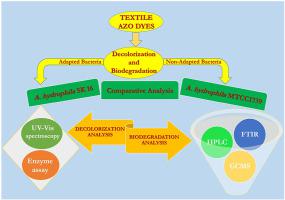Environmental Research ( IF 7.7 ) Pub Date : 2020-12-29 , DOI: 10.1016/j.envres.2020.110643 Shantkriti Srinivasan , Senthil Kumar Sadasivam

|
Textile effluent discharged in water and soil have severe effects on living beings as well as environs worldwide. Pioneering, ecologically sustainable and economically viable treatment systems are urgently desired. This study investigated decolorization along with degradation of three azo dyes by non-adapted Aeromonas hydrophila MTCC 1739 and textile-effluent adapted Aeromonas hydrophila SK16 bacteria under optimized physicochemical conditions. UV–visible analysis (for decolorization percentage calculated using absorbance), FTIR (fourier transform infrared spectroscopy for functional group identification), HPLC (high performance liquid chromatography for degraded metabolites analysis based on retention time) and GC-MS (gas chromatography-mass spectrometry for proposing degradative pathways based on mass/charge as well as molecular weight) supported efficient biodegradation of these dyes into simpler metabolites by both cultures. Time taken for decolorization by the adapted strain was less but both were equally efficient in mineralizing dyes, utilizing them as energy source. Enzyme assays revealed over-expression of dye degrading enzymes in presence of toxic azo dyes. Thus, it is suggested that both adapted and non-adapted bacteria act as azo dye degraders with potential use in efficient and lucrative effluent treatment curbing expansive preliminary screening of autochthonous strains for azo dye degradation.
中文翻译:

纺织废水未适应和适应的嗜水气单胞菌对纺织品偶氮染料的生物降解
排放到水和土壤中的纺织品废水对全世界的生物和周围环境均造成严重影响。迫切需要开拓,生态上可持续和经济上可行的处理系统。这项研究研究了非适应性嗜水气单胞菌MTCC 1739和适应纺织品废水的嗜水气单胞菌对三种偶氮染料的脱色以及降解优化理化条件下的SK16细菌。紫外可见分析(用于通过吸光度计算的脱色百分比),FTIR(用于功能组识别的傅立叶变换红外光谱),HPLC(用于基于保留时间的高效液相色谱法用于降解代谢物的分析)和GC-MS(气相色谱-质谱法) (基于质量/电荷以及分子量提出降解途径的方法)支持通过两种培养将这些染料有效地生物降解为较简单的代谢物。适应菌株进行脱色所需的时间更少,但在利用它们作为能源矿化染料方面,两者都同样有效。酶分析显示,在有毒的偶氮染料存在下,染料降解酶过度表达。从而,











































 京公网安备 11010802027423号
京公网安备 11010802027423号